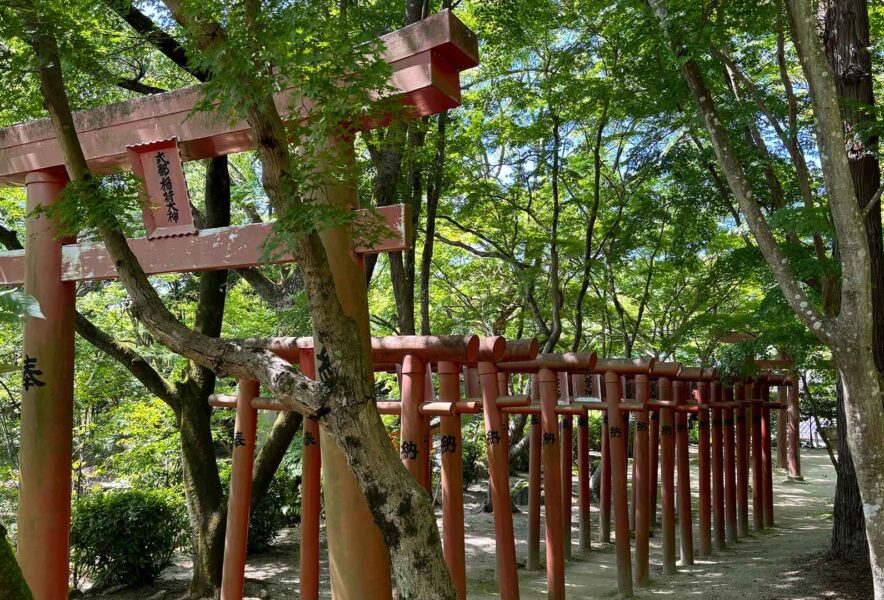Dazaifu is a historical city that flourished when the Dazaifu, the governing body of the Kyushu region, was established. Home to Dazaifu Tenmangu Shrine and many historical sites, it is also a popular tourist destination, attracting more than 10 million visitors each year. It is a treasure trove of history and culture, and its rich heritage can be explored. Dazaifu Tenmangu Shrine enshrines Sugawara no Michizane, who has been worshipped as the god of learning, and attracts many students and students preparing for entrance exams. The Kamakamon Shrine is known as the god of marriage and family safety, and its quiet atmosphere is calming. And at the Kyushu National Museum, visitors can learn about the origins of not only Kyushu but also Japan through cultural assets and historical exhibits. During a walk in Dazaifu, you can experience the history and culture of Dazaifu and have a moment to heal your mind through the city’s scenery and interaction with the local people.
- Access to Dazaifu
- A. Historical and Cultural Tour of Dazaifu, Fukuoka Prefecture on foot from Dazaifu Station Start
- B Dazaifu Tenmangu Shrine
- C.Kamadojinja Shrine
- Access to Kamadojinja Shrine
- D. Kyushu National Museum
- E. Dazaifu Amusement Park
- F. Dazaifu station
- Dazaifu Walking A Walking Tour of the History and Culture of Dazaifu, Fukuoka Prefecture Summary
- Access to each facility
Access to Dazaifu
Access to Dazaifu is very convenient. Here is how to access from Fukuoka City.
Access by train
From Fukuoka Airport
- From Fukuoka Airport, take the Airport Subway Line to Hakata Station (approx. 5 min.).
- From Hakata Station, take the JR Kagoshima Main Line to Futsukaichi Station (approx. 15 minutes).
- At Futsukaichi Station, transfer to the Nishitetsu Omuta Line for a 5-minute ride to Dazaifu Station.
From Hakata Station
- From Hakata Station, take the JR Kagoshima Main Line to Futsukaichi Station, about 15 minutes.
- At Futsukaichi Station, transfer to the Nishitetsu Omuta Line for a 5-minute ride to Dazaifu Station.
From Tenjin Station
- From Nishitetsu Fukuoka (Tenjin) Station, take the Nishitetsu Omuta Line to Futsukaichi Station (approx. 20 minutes).
- Transfer at Futsukaichi Station to Nishitetsu Dazaifu Line for a 5-minute ride to Dazaifu Station.
Access by bus
Direct buses to Dazaifu are also available from Fukuoka City. Buses departing from Fukuoka Airport or Hakata Station will take you to Dazaifu in approximately one hour without the hassle of changing trains.
Access by car
If you choose to travel by car, it takes about 30 minutes to 1 hour from Fukuoka City to Dazaifu. You can arrive smoothly by taking the Kyushu Expressway and getting off at the Dazaifu Interchange. However, since Dazaifu city is often crowded with tourists, advance reservation of a parking lot is recommended.
A. Historical and Cultural Tour of Dazaifu, Fukuoka Prefecture on foot from Dazaifu Station Start

Introduction of Dazaifu Station
Dazaifu Station is a major transportation hub located in the center of Dazaifu City. It is the terminal station of the Nishitetsu Dazaifu Line, and many tourists use it as a starting point to explore the attractions of Dazaifu. The station building is designed in a Japanese style, and one can feel the traditional Japanese atmosphere from the moment of arrival. There is a tourist information center in front of the station, where you can obtain maps, pamphlets, and tourist information, even for first-time visitors.
Highlights around the station
Approach to Dazaifu Tenmangu Shrine
Immediately after exiting Dazaifu Station, the approach leading to Dazaifu Tenmangu Shrine spreads out. Both sides of the approach are lined with souvenir stores and restaurants, creating a pleasant atmosphere just by walking along. Particularly famous is the famous “Umegae-mochi” rice cake, which is freshly baked and can be enjoyed throughout the approach.
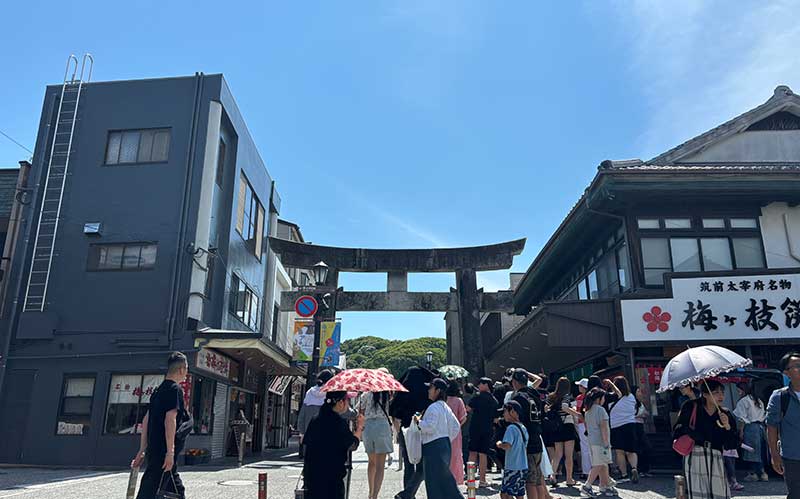

Starbucks Coffee Dazaifu Tenmangu Omotesando Store
In the middle of the approach is a uniquely designed Starbucks, designed by architect Kengo Kuma. The store, with its abundant use of wood, is well worth a visit. It is the perfect place to take a break from sightseeing.

B Dazaifu Tenmangu Shrine
Walking along the approach to the shrine, you will see your destination, Dazaifu Tenmangu Shrine. This shrine, dedicated to Sugawara Michizane, the god of learning, is crowded every year with many students preparing for entrance exams and worshippers wishing for academic success. The vast shrine grounds are filled with many sights to see.


History and Origin of Dazaifu Tenmangu Shrine
Dazaifu Tenmangu Shrine is dedicated to Sugawara no Michizane, known as the god of learning. During the Heian period (794-1185), Sugawara no Michizane was involved in a political conspiracy and was left behind in Dazaifu, far from Kyoto. After his death, a shrine was built to comfort his soul. This is the origin of Dazaifu Tenmangu Shrine. Because of Michizane’s passion for learning, Tenmangu Shrine is still visited by many people who wish for academic success.

Places to visit in the precincts
Main Shrine
The main shrine is the central building dedicated to Michizane. The beautiful vermilion building is of great historical value and is designated as a National Important Cultural Property. Worshippers join hands in front of the main hall to pray for academic success and other wishes.
Arched bridge
Upon entering the temple grounds, the first thing you will see is the Taiko-bashi Bridge. This beautiful, arc-shaped bridge consists of three bridges, each representing the past, present, and future. Crossing this bridge is meant to purify the body and soul.
Ume (plum) grove
The plum grove, planted with plum trees loved by Michizane, is home to about 6,000 plum trees, and beautiful plum blossoms adorn the grounds in the spring. The legendary “flying plum tree,” called “飛梅 Tobibai,” is especially a must-see.
(shrine) repository or treasure house
In the Treasure House, valuable materials and artifacts related to Michizane are on display. It is a popular place for many people to experience history.
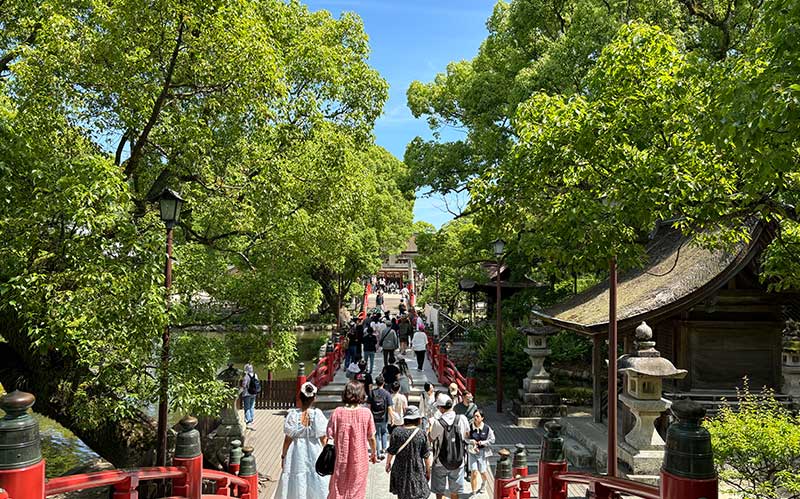



Seasonal attractions (plum blossoms, festivals, etc.)
Ume (plum) blossoms
The plum grove at Dazaifu Tenmangu Shrine is in full bloom from February to March each year. About 6,000 plum trees are in full bloom, and the precincts are filled with the fragrance of plum blossoms. The Ume Blossom Festival is also held, attracting many tourists.
Summer festival
In summer, a large-scale festival called “Tenjin Matsuri” is held. The festival includes a spectacular portable shrine, parades, and fireworks displays, and is crowded with locals and tourists alike.
(Japanese) maple (Acer japonicum)
In autumn, the trees on the temple grounds turn red, creating a beautiful view of the autumn leaves. The contrast between the moss garden and the autumn leaves at Koumyou Zenji Temple is particularly stunning and well worth seeing.
Winter Lighting up
In winter, the precincts of the temple are lit up, creating a fantastic atmosphere. Special events are held especially during the Christmas season, attracting many visitors.

The head temple of the god of learning
Sugawara Michizane is revered as the “God of Learning” for his outstanding academic knowledge and poetic talent. Especially during the examination season, many students and their families from all over Japan visit the shrine to pray for academic success. At Dazaifu Tenmangu Shrine, visitors can be seen writing their wishes for academic success on ema (votive tablet) votive tablets, which shows the depth of their devotion to Michizane.


Walk to the Kamadojinja Shrine. From Dazaifu Tenmangu Shrine to Kamadojinja Shrine is an uphill walk all the way, which takes about 30 minutes on foot.

C.Kamadojinja Shrine


History and Mythology of Kamadojinja Shrine
Kamadojinja Shrine is an ancient shrine with a history of over 1,300 years. The shrine was built in the Heian period (794-1185) and is dedicated to the god of fire, Homusubi no Mikoto. Kamadojinja Shrine is also notable for having the same surname as that of “Kamado Tanjiro,” a character in the book ” Kimetsu no Yaiba” (The Blade of Demons).
According to mythology, Hi-zan-no-Mikoto, the god of fire, has been an integral part of people’s lives since ancient times, and Kamadojinja Shrine has served to protect people from fire and disaster by worshipping this deity.
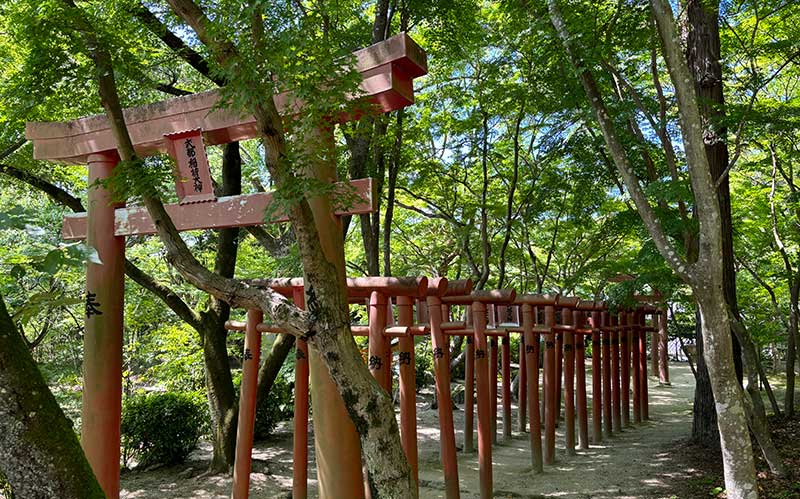
Access to Kamadojinja Shrine
Access by bus
A community bus runs from in front of Dazaifu Tenmangu Shrine and goes directly to Kamadojinja Shrine. The trip takes about 10 minutes, and you can enjoy the scenery of Dazaifu City from the bus window. However, the number of buses is limited, so you need to check the number of buses.
Places of interest and natural beauty on the grounds of the shrine.
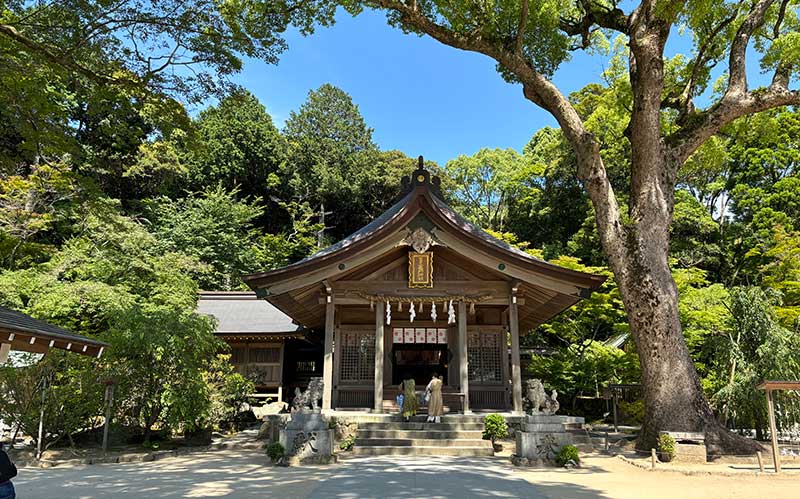
Main shrine
The main shrine building is the center of the shrine and has a solemn atmosphere. The wooden structure is beautiful and evokes a sense of history.
Kagura hall (at a shrine)
There is also a kaguraden (a Shinto music and dance hall) on the grounds where festivals and Shinto rituals are held. Traditional dances and music are sometimes dedicated, and depending on the timing of your visit, you may be able to have a special experience.
Nature trail
The shrine is surrounded by nature trails that allow visitors to enjoy the scenery of the four seasons. Each visit offers a different beauty: cherry blossoms in spring, green trees in summer, autumn leaves in fall, and snowy landscapes in winter.
Attraction as a power spot for love fulfillment
Kamadojinja Shrine is also known as a power spot for love fulfillment. The shrine grounds are dotted with places that are believed to be beneficial for romance and marriage.
Stone of luck in love
The stone of love fortune on the temple grounds is said to improve one’s luck in love by touching it. Many couples and people wishing for the fulfillment of love visit the temple.
Amulet for love fulfillment
Amulets for love fulfillment are sold at the shrine. The beautifully designed amulets are popular as souvenirs.
Ema
An ema is a votive picture.Ema are wooden plaques that people write their prayers or wishes on.People who wish for the fulfillment of love write their wishes on Ema and dedicate them. Ema hangings are lined with ema with various wishes written on them, and visitors can experience the feelings of many people just by looking at the ema.


Walk to the Kyushu National Museum. Follow the same path you walked from Dazaifu Tenmangu Shrine, this time going downhill.
It is recommended to check the bus time and take the bus down on the way back.
D. Kyushu National Museum
The Kyushu National Museum is the fourth national museum following Tokyo, Kyoto, and Nara. Located on the grounds of Dazaifu Tenmangu Shrine, the museum was designed by Kiyonori Kikutake, a native of Kurume City. Unlike other national museums, the museum’s exhibits are positioned as a history museum.



Highlights of Permanent and Special Exhibits
Exhibits at the Kyushu National Museum focus primarily on the history and culture of Japan and Asia. Here are some highlights of the permanent and special exhibits.

Permanent exhibit
Dawn of Japanese Culture
This exhibit introduces the development of Japanese culture from the Jomon to the Yayoi and Kofun periods. Ancient artifacts, earthenware, and armaments are on display to provide visitors with a deeper understanding of ancient Japanese life and culture.
Interaction with Asia
This exhibit focuses on the exchange between Japan and other Asian countries. Visitors can learn about the impact on Japan of culture and technology introduced from China and the Korean Peninsula. Of particular interest are the materials related to the Japanese envoys to the Tang Dynasty and Sui Dynasty.
Religions and Beliefs in Japan
Introduces the history of religions and beliefs in Japan, including Buddhism, Shintoism, and Christianity. Through exhibits such as Buddhist statues, sutras, and sacred objects, visitors can experience the diversity of Japanese religious beliefs and religions.

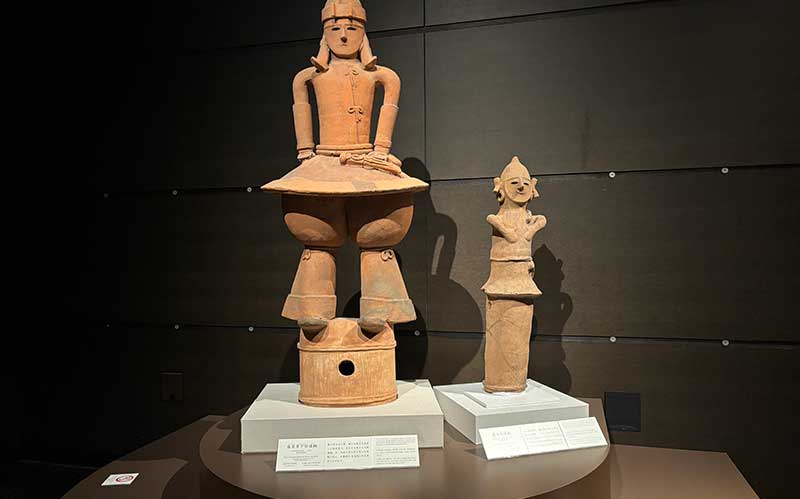
Special Exhibits
Special exhibitions are held regularly at the Kyushu National Museum, covering a wide range of themes. Past exhibitions have included “The Beauty of Ukiyoe,” “Treasures of the Orient,” and “Modern Japanese Masterpieces,” offering something new to discover each time you visit. Special exhibits are only available for a limited time, so visitors are advised to check the official website before visiting.
Museum architecture and its attractions
The Kyushu National Museum building is also known for its unique architectural design. Created by architect Kiyonori Kikutake, the building’s beautiful curves harmonize with nature and captivate visitors.
Integration with Nature
The exterior of the museum is designed to harmonize with the surrounding natural environment. The glass façade blends in with the mountain greenery, allowing visitors to enjoy beautiful views from inside the museum.
Large exhibition space
The museum interior is spacious and features large exhibition spaces. The high ceilings and open design allow visitors to view the exhibits in a relaxed atmosphere.
Latest Exhibit Technology
The museum is equipped with the latest in exhibit technology, allowing visitors to enjoy video, audio, and interactive exhibits. This allows visitors to experience the exhibits not only visually, but also with the senses of hearing and touch.
(Extra) For those with children, there is an amusement park on the grounds of the Dazaifu.


E. Dazaifu Amusement Park

A good place to bring children
Dazaifu Amusement Park is especially recommended for families when visiting Dazaifu. Located near Dazaifu Tenmangu Shrine, this amusement park has an at-home atmosphere that can be enjoyed by both small children and adults. Several retro rides are available.
Amusement Park Attractions and Attractions
Nostalgic attractions
Dazifu Amusement Park offers many nostalgic retro attractions that can be enjoyed by both parents and children. There is a full lineup of rides that even small children can safely ride, making it an ideal first amusement park experience.
Merry-go-round: A merry-go-round with spinning brightly colored horses is very popular with young children. Parents and children can enjoy riding together.
Ferris Wheel: Although modest in height, the Ferris wheel offers a panoramic view of Dazaifu. Families can spend a relaxing time together while enjoying the scenery.
Mini Train: The mini train that runs slowly through the park is very popular among children. Visitors can enjoy a leisurely ride while overlooking the entire amusement park.
Seasonal Events
Dazifu Amusement Park offers a variety of seasonal events. Visitors can enjoy special seasonal decorations and attractions such as summer festivals, Halloween, and Christmas. Especially during the Christmas season, illumination and photo-taking events with Santa Claus will provide special memories for children.
Workshops for children
Workshops are regularly held in the amusement park for children to enjoy and learn. There are a wide variety of experiences for parents and children to participate in, such as handmade crafts and baking sweets. This allows them to not only play, but also have a fun time stimulating their creativity.

Eating and Resting spots
family restaurant (varied menu options, inexpensive)
Dazifu Amusement Park has a family restaurant where you can dine with your children. The restaurant offers a full range of children’s menus, providing meals that can be enjoyed by the whole family.
Kids’ menu: Hamburgers, curry and rice, spaghetti, and other dishes to please children.
Baby chairs: Baby chairs and children’s tableware are available for those with small children.
Picnic areas
The park also has a picnic area where you can spread out your own lunch. On fine days, families can relax while enjoying a picnic.
Walk to the Dazaifu station.
F. Dazaifu station
After enjoying Dazaifu Tenmangu Shrine, Kamadojinja Shrine, and Kyushu National Museum, the return trip to Dazaifu Station is another fun part of the tour. There are many cafes and stores along the approach that you may want to stop by.
Recommended Cafes and Shops
Tour of Famous Umegae Mochi Shops
Umegae mochi (rice cake) is one of the most famous sweets in Dazaifu. This Japanese confectionery, with its mochi (glutinous rice cake) texture and sweet red bean paste, is a must-try. Many stores selling Umegae mochi line the approach to the temple, and it is recommended to compare the different types.
Kasanoya: Long-established shop in front of Dazaifu Tenmangu Shrine. The freshly baked umegae mochi (plum cake) is excellent.
Matsuya: Located right next to the train station, it is easy to stop by on your way home.
Take a break at a stylish cafe
Stylish cafes that blend the traditional with the modern are scattered along the approach to the temple. Take a break from sightseeing and enjoy local delicacies.
Starbucks Coffee Dazaifu Tenmangu Omotesando: Uniquely designed by Kengo Kuma. The interior is attractive with its abundant use of wood.
Official Site:Click here
Kagunokonomi: In this café, which was renovated from an old private house, you can enjoy Japanese sweets while enjoying the Japanese atmosphere.
Official Site:Click here
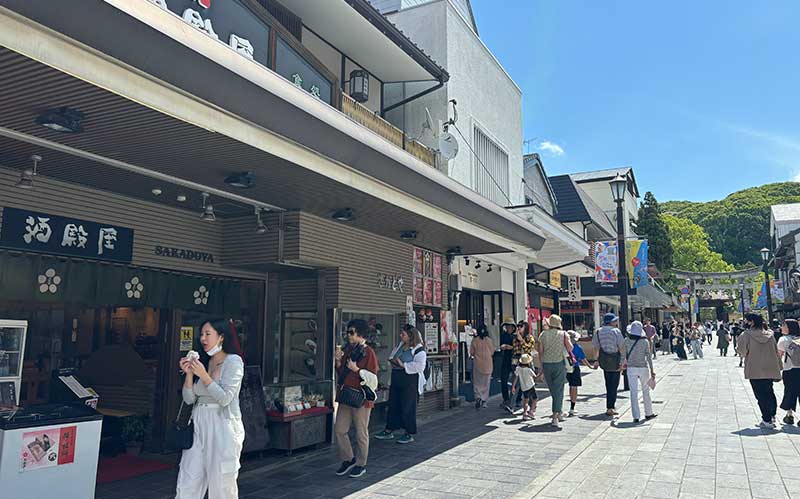

Dazaifu Walking A Walking Tour of the History and Culture of Dazaifu, Fukuoka Prefecture Summary
A trip to Dazaifu is a wonderful experience that blends history, nature, and culture. Through the majesty of Dazaifu Tenmangu Shrine, the natural beauty of the Kamadojinja Shrine, and the intellectual exploration of the Kyushu National Museum, you will gain a deep sense of Japan’s cultural heritage from ancient times to the present day. Eating and drinking on the bustling approach to the station and spending time in the fashionable cafes around the station will further enrich the enjoyment of your trip.
All in all, Dazaifu is a fascinating place with so many attractions that one day is not enough. By experiencing its historical legacy, being surrounded by soothing nature, and enjoying delicious food, you are sure to have a trip that will refresh your body and soul.
Access to each facility
Dazaifu Tenmangu Shrine
-Address: 4-7-1 Zaifu, Dazaifu City, Fukuoka Prefecture
-TEL:092-922-8225
-Hours: 6:00-19:30 throughout the year (closed, depending on the time of year)
-Parking: Available/1,000 spaces, 500 yen per car
-Official Site:Click here
Kamadojinja Shrine
-Address: 883 Dazaifu City Yama
-TEL:092-922-4106
-Access: 10 minutes from Nishitetsu Dazaifu Station by community bus “Mahoroba-go” bound for Uchiyama, and alight at the last stop.
-Hours: Free in the precincts (8:30 a.m. to 6 p.m. for the awarding office)
-Parking: 100 cars (400 yen per car)
-Official Site:Click here
Kyushu National Museum
-Address: 4-7-2 Ishizaka, Dazaifu City, Fukuoka Prefecture
-TEL:050-5542-8600
Closed: Mondays, closed the following day if Monday is a national holiday. Closed at the end of the year.
-Admission: Adults 700 yen, college students 350 yen (4th floor Cultural Exchange Exhibition), special exhibitions are extra.
Free admission for high school students and younger, persons under 18, and persons over 70 (with proof of age); free admission for the disabled and one caregiver with a disability certificate.
-Parking: Available / 313 spaces, 500 yen per charge
Parking fee waiver for those with disabilities (original copy of disability certificate)
-Official Site:Click here
Dazaifu Amusement Park
-Address: 4-7-8 Zaifu, Dazaifu City, Fukuoka Prefecture
-TEL:092-922-3551
-Hours: 10:30-16:30 throughout the year, 10:00-17:00 on Saturdays, Sundays, and holidays
-Closed: irregular, with occasional closures in July and December
-Admission: Admission = 600 yen for adults (junior high school students and older), 400 yen for children (3 years old to elementary school students) / Ride fees = 300-500 yen / Train coaster = 400 yen / Water coaster = 400 yen
Admission is 500 yen for those 65 years old and over, and half price for the disabled.
-Parking None/
Use Dazaifu Tenmangu Grand Parking Lot, 500 yen, or use nearby parking lots.
Official Site:Click here
